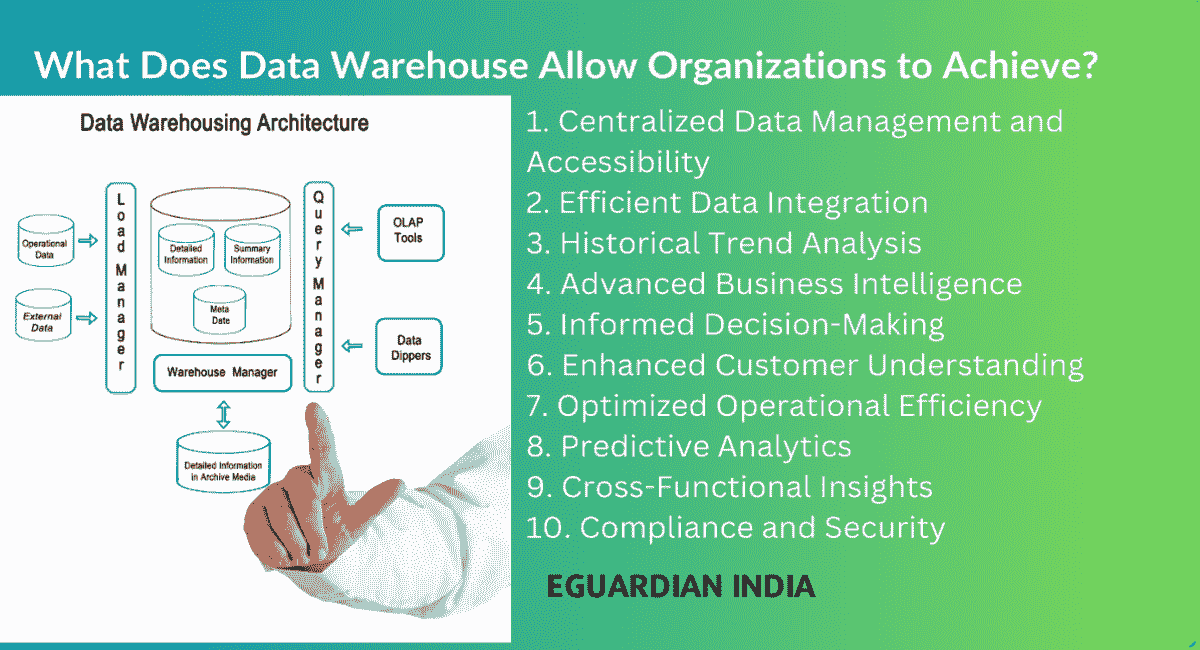What does Data Warehouse allow Organizations to achieve?
What does Data Warehouse allow Organizations to achieve?

In the modern era of data-driven decision-making, organizations are leveraging the power of data warehousing to achieve many strategic goals. A data warehouse serves as a robust repository beyond merely storing data; it empowers businesses to extract actionable insights, make informed decisions, and gain a competitive edge.
In this technical blog post, we will delve into the transformative capabilities of data warehousing and explore how it enables organizations to achieve their objectives.
Understanding Data Warehousing: A Foundation for Growth
What is Data Warehousing?
The process of data warehousing encompasses the meticulous accumulation, storage, administration, and evaluation of massive quantities of structured and unstructured data derived from diverse origins within an enterprise.
The purpose is to facilitate informed decision-making, streamline operations, and enhance efficiency.
The Key Components of Data Warehousing
A well-architected data warehouse comprises several key components, each contributing to its seamless functionality:
1. Data Sources: These are data origins, ranging from internal systems (like CRMs and ERPs) to external sources (like, social media platforms and third-party databases).
2. ETL Processes: Extract, Transform, Load (ETL) processes involve extracting data from various origins standardizing its structure, and importing it into the system.
3. Data Storage: The data warehouse serves as a centralized repository, efficiently storing data for easy access and retrieval.
4. Data Modeling: This involves structuring data to support efficient querying and analysis, often through techniques like star or snowflake schemas.
5. Query and Analysis Tools: Data warehousing provides powerful tools for querying and analyzing data, allowing organizations to derive meaningful insights.
What does Data Warehouse allow Organizations to achieve?
The Data Warehouse allow Organizations to achieve the following
1. Centralized Data Management and Accessibility
A data warehouse allows organizations to centralize data from various sources, eliminating data silos and ensuring a single source of truth.
The consolidation of data management simplifies the process and allows authorized users to effortlessly retrieve pertinent information for analysis and reporting.
2. Efficient Data Integration
With data warehouse architecture, organizations can integrate data from disparate systems, databases, and applications. This integration eliminates the need for manual data consolidation, saving time and minimizing errors.
3. Historical Trend Analysis
Data warehousing allows organizations to store historical data over time, enabling them to analyze trends, patterns, and changes across different periods. This historical context aids in forecasting, identifying opportunities, and mitigating risks.
4. Advanced Business Intelligence
Data warehouses empower organizations to conduct advanced business intelligence activities. Through querying, reporting, and data visualization, decision-makers gain insights that facilitate informed strategic planning.
5. Informed Decision-Making
By providing a consolidated view of data, a data warehouse equips organizations with accurate and up-to-date information, enhancing the quality of decision-making. Real-time and historical data help leaders make decisions based on facts rather than assumptions.
6. Enhanced Customer Understanding
Data warehousing allows organizations to analyze customer behavior, preferences, and purchasing patterns. This insight enables personalized marketing strategies, better customer service, and improved customer retention.
7. Optimized Operational Efficiency
Organizations can use data warehouses to analyze operational processes and identify bottlenecks or inefficiencies. This information drives process optimization and improves overall operational efficiency.
8. Predictive Analytics
Data warehouses enable organizations to perform predictive analytics by analyzing historical data to forecast future trends and outcomes. This capability enhances strategic planning and risk assessment.
9. Cross-Functional Insights
Data warehouses facilitate cross-functional collaboration by providing a unified platform for various departments to access and analyze data. This fosters a holistic view of the organization’s performance and aligns strategies.
10. Compliance and Security
Data warehousing allows organizations to implement robust security measures and access controls, ensuring compliance with data protection regulations and safeguarding sensitive information.
The Transformative Benefits of Data Warehousing
1. Enhanced Decision-Making
Data-driven decision-making is at the heart of every successful organization. A robust data warehousing solution empowers decision-makers with timely, accurate, and relevant insights, enabling them to make informed choices that drive growth and innovation.
2. Improved Data Quality and Consistency
Data inconsistencies can lead to erroneous conclusions and misguided strategies. Data warehousing ensures data integrity by standardizing formats and eliminating duplications, leading to a single source of truth for the entire organization.
3. Accelerated Business Intelligence
Timely access to critical business intelligence is vital for staying ahead in today’s competitive landscape. Data warehousing expedites the process of data retrieval and analysis, enabling faster response times to market trends and opportunities.
4. Streamlined Operations
Efficiency is a hallmark of successful organizations. Data warehousing streamlines operations by providing a unified view of data, reducing the time spent gathering and reconciling information from various sources.
5. Scalability and Flexibility
As organizations grow, so does their data. Data warehousing solutions offer scalability and flexibility, ensuring that the infrastructure can accommodate increasing volumes of data without compromising performance.
Implementing Data Warehousing: A Strategic Approach
1. Assessing Organizational Needs
Before embarking on a data warehousing journey, organizations must assess their specific needs and objectives. This involves identifying key pain points, potential opportunities, and desired outcomes.
2. Choosing the Right Data Warehouse Solution
Selecting the appropriate data warehousing solution is crucial. Factors such as scalability, compatibility with existing systems, and vendor support play a pivotal role in making an informed decision.
3. Data Migration and Integration
Migrating data from legacy systems to a new data warehouse requires careful planning and execution. Seamless integration ensures minimal disruption to ongoing operations.
4. Establishing Robust Security Measures
Data security is non-negotiable. Implementing robust security measures, including encryption, access controls, and regular audits, safeguards sensitive information and maintains compliance with industry regulations.
Conclusion:
In the era of data-driven decision-making, a well-implemented data warehousing solution serves as the backbone of organizational success. Data warehousing empowers organizations to outperform their competitors and achieve unprecedented growth by centralizing data, enhancing data quality, and expediting analysis.
In order to successfully navigate the challenges of the modern business landscape, companies must not only consider data warehousing as an option but also view it as a crucial strategic imperative.





